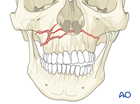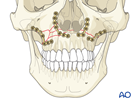Closed treatment
Main indications
Fractures with minor malocclusion readily correctable with maxillary manipulation, and not grossly mobile after repositioning may be treated closed. However, closed reduction is more commonly used in conjunction with other stabilization techniques (skeletal suspension, external fixators, etc.).
Further indications
- Premorbid or unstable medical condition preventing general anesthetic
- Conditions making open reduction and internal fixation difficult
- Patient refusal of operative treatment (eg, for religious/cultural or financial reasons)
- Unavailability of plates and screws
Special consideration: MMF may be contraindicated in patients with psychiatric disorders, seizure disorders, and alcoholics.
Fractures with minor malocclusion readily correctable with maxillary manipulation, and not grossly mobile after repositioning may be treated closed. However, closed reduction is more commonly used in conjunction with other stabilization techniques (skeletal suspension, external fixators, etc.).
Further indications
- Premorbid or unstable medical condition preventing general anesthetic
- Conditions making open reduction and internal fixation difficult
- Patient refusal of operative treatment (eg, for religious/cultural or financial reasons)
- Unavailability of plates and screws
Special consideration: MMF may be contraindicated in patients with psychiatric disorders, seizure disorders, and alcoholics.















